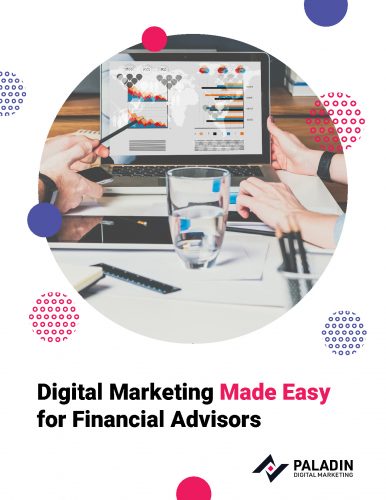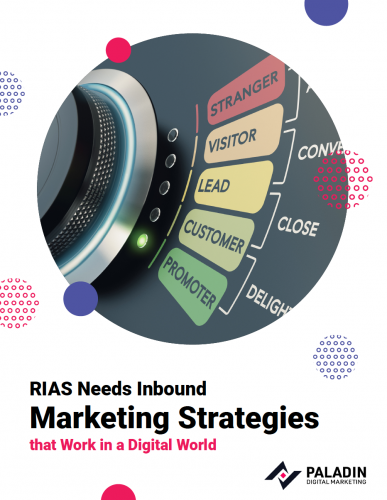Guide to Financial Advisor Marketing

The world is changing fast, and so are the marketing practices of more astute financial advisors who understand the impact of the Internet on the ways they market their services to individual investors. It should not be a surprise that investors are using the Internet to find, screen, and contact financial firms and professionals.
This pace is accelerating as increasing numbers of investors figure out how they can use the Internet to make better decisions when they select financial advisors. This trend transfers substantial power to investors who are anonymous until they contact the advisors they want to interview.
Even more extreme, when investors compare financial advisors on the Internet they can determine who is practicing transparency and who is withholding important information from them.
This guide about digital marketing for financial advisors will help you transition to an online strategy that produces organic growth for your firm.
Why is outbound marketing for financial advisors in decline?
Not long ago, financial advisors used a var experienced by the broker-dealers of these advisors. After they contacted friends and family, they had to start contacting people they did not know and that was when the massive amounts of rejection started.
Various technologies like Caller ID and spam filters have made outbound marketing even less productive. Advisors are lucky if 100 telephone calls produce one genuine prospect for their services.
Can we say outbound marketing is dead? No, we can’t say that. But, even some of the major wirehouses have abandoned these boiler room sales tactics due to their invasive nature, low productivity, and aggressive sales image.
Why does referral-based marketing have limited potential?
When we talk to financial advisors about their current marketing strategies, more than 60% say their principal strategy is referrals from their current clients, friends and family, and Centers of influence
There is no question that referrals produce a financial advisor’s best source of high quality leads for the sale of their advice and services. A referral has a predisposition that the financial advisor is credible and trustworthy. The more they trust the referral source the more they trust the financial advisor. This is a major competitive advantage that converts more prospects into revenue generating clients..
The quality of the leads is not the issue. The quantity of leads that are produced by referrals is the main issue. Many financial advisors are reluctant to ask clients, friends, and family for referrals, so they must wait for the telephone to ring.
Consequently, most financial advisors say they receive a few referrals each year. Then they say they convert about 50% of them into revenue-producing clients – an excellent close ratio. The problem is a few conversions (two-four) barely cover the losses that financial advisors experience each year due to terminations, deaths, and relocations.
This leads us to say referrals are not a viable strategy for long-term organic growth.
What caused the rise of digital marketing for financial advisors?

The Internet has been a game changer for several industries. It has changed how entire industries market their products and services to their customers and clients.
Assuming the Internet will not have an impact on the financial service industry would be foolhardy. In fact, financial advisor marketing is the perfect application of Internet marketing (also known as digital marketing and inbound marketing) because it is based on an exchange of information.
The Internet gives investors access to vast amounts of information about financial professionals and the firms they work for. Our data shows when investors are seeking financial advisors, 82% will visit the advisors’ websites, and 64% will Google search their names.
This is one of the key benefits of digital marketing for financial advisors. In this case, investors initiate contact with financial advisors. There are no longer any invasive sales tactics. Does is work? This is how lead generation companies (WiserAdvisor, SmartAsset) produce thousands of leads per month that they sell to financial advisors.
How does the Internet transfer power to investors?
Back in the day, when outbound marketing was the dominant force, investors had to talk to financial advisors to learn more about the firms and the professionals who worked for them. This opened the door to the invasive sales tactics that financial advisors used back in the day. The most successful investment professionals were often the advisors (stockbrokers) with the best sales skills.
We have already said the Internet is a game changer because it gives investors unprecedented access to vast amounts of information about financial firms and the professionals who work there.
Because investors initiate the contact, what they see on the Internet (website, Google name search) determines who they contact for interviews. And, the more they learn about financial advisors on the Internet, the higher the probability they will select a higher quality professional.
Consider this scenario. An investor visits eight financial advisor websites and contacts four for interviews. What they see on websites helps them compare financial firms to each other. Some of the firms practice transparency and some do not. Investors are beginning to figure that out.
How can the Internet create credibility and trust for financial advisors?
There is an old saying in the financial service industry: “That money moves on trust.” It makes perfect sense that investors select financial advisors that they believe are trustworthy experts. And trustworthiness can be based on credibility, consistency, and honesty.
The question is, how do financial advisors use the Internet to create credibility and trust?
One answer is the information that resides on the financial advisors’ websites. Do the sites deliver the information that investors are seeking? This is where financial advisor content marketing comes into play. Financial advisors use content marketing, social media, and other tactics to build credibility and trust.
A second answer is the financial advisors’ willingness to disclose information about their firm's credentials and business practices. For example, information that describes how financial advisors are compensated for their advice and services. Very few financial advisors disclose their fee schedules. A much bigger percentage discloses the way they are compensated, but not how much. A significant percentage, who receive commissions, prefer to ignore the topic in its entirety.
And third, what do investors see when they Google search the financial advisors’ names? Ideally, they will see substantial amounts of high-quality content that establish the advisors as trustworthy financial experts.
This is the information investors must see before they are comfortable giving up their anonymity and contacting financial advisors. Find out how financial events should impact the digital marketing strategies of financial advisors.
How can content marketing create Internet visibility for financial advisors?

Internet visibility is the key to digital marketing success. The more visible your firm is online, the easier you are to find. The easier you are to find, the more visitors you generate for your website. The more visitors you have to your website, the more leads your website can produce for your marketing team.
The number one SEO (Search Engine Optimization)strategy for building Internet visibility is content marketing.
Investors go to Google and enter keywords to find what they are seeking. For example, “find a financial advisor near medd.” Ideally, these keywords will lead them to articles you have written, and the articles will lead them to your website, where you have the opportunity to convince them to contact you.
How is social media a great way to leverage your visibility?
Social media is an increasingly powerful tool that financial advisors can use to:
- Increase the visibility of their brands on the Internet
- Expand the visibility of their content
- Interact directly with potential clients
- Build and expand networks
- Launch promotions, distribute information, and generate leads
An essential part of this strategy is leveraging every piece of content published on your website and blog. The more you leverage your content, the greater your return on the marketing dollars you spend to produce the content.
It makes sense that the more your content is seen, the more valuable it is for your firm. This is also true for engagement. Your target markets must open and read your content to have SEO (Search Engine Optimization) value.
This makes a steady flow of high-quality content distributed in search engines and social media channels extremely valuable. You achieve maximum effectiveness when you leverage the visibility of your content.
Why should Local SEO be part of your digital marketing foundation?
 The answer is Google. It has a predisposition to connect buyers to local service providers. In fact, it has been reported that 24.7% of Google’s website ranking algorithm is based on local visibility.
The answer is Google. It has a predisposition to connect buyers to local service providers. In fact, it has been reported that 24.7% of Google’s website ranking algorithm is based on local visibility.
When it comes to financial advice and services, investors may also have the same predisposition – a local service provider they can meet with face-to-face.
The predisposition of investors has been evolving with financial advisor business practices, so virtual marketing and servicing are more acceptable to more people. But, financial advisors should be prepared to offer prospects a choice. Let them choose the type of interaction they are most comfortable with. The more visible you are locally, the more visible you are on the Internet. Keep in mind that visibility is your key to success as long as it provides traffic to your website and increases your flow of new leads.
Why are email marketing campaigns important for financial advisors?
Not every investor is using the Internet to find financial advisors. A much bigger number is seeking financial information that could include data about the financial advisors providing the information.
A frequent alternative is investors collecting financial advisor information while they are still in their fact-gathering phase. They intend to use the content later when they are ready to start interviewing financial advisors.
These contacts will end up in your CRM or another system where you store names and contact information. Then you keep your name in front of them with monthly or bi-monthly emails that help you build credibility and trust.
Your goal is to create a competitive advantage so that when they interview financial advisors they include you.
What kind of CRM for financial advisors are you using?
Why use SEM to produce more leads for financial advisors?
SEM is Search Engine Marketing. This online strategy uses paid advertising campaigns to build or supplement your online visibility. Instead of using SEO to build website visibility over time, you can buy your visibility very quickly. In fact, many financial advisors do both to accelerate their flow of leads.
Google and Facebook are two of the more popular channels.
Why are financial advisor websites so important?
Think of the time and expense you have spent building your visibility on the Internet and producing traffic for your website. Only to have investors visit your website and exit it without leaving their contact information.
Your website has a one-time opportunity to convince visitors to submit their contact information. And, it may only have three minutes (average time on site) to make this happen.
Your website has to deliver critical information to investors that they use to compare your firm to other financial advisors:
- Background information for your firm (about us)
- Who you serve (ideal clients)
- What you do (your services)
- Why select your firm (differentiating characteristics)
- A Resource Center (financial information)
All of this information is delivered by intuitive navigation. Investors will exit financial advisor websites before they will search for information.
What are frequent traps that impact financial advisor marketing?
Following are the top five traps that negatively impact the success of financial advisor marketing.
- They have rented or purchased websites that are nothing more than online sales brochures. Their websites are not designed to convert visitors into qualified leads.
- Every advisor has a website, but they are not doing anything to produce website traffic. Traffic requires Internet visibility.
- Advisors are downloading articles from libraries that have no SEO value. Google and the other search engines have already seen the content hundreds or thousands of times. No SEO means no Internet visibility and no website traffic.
- Advisors write their own original content, but it is the wrong type of content. For example, they write about general financial topics that are lost on the Internet. How do you compete with the Wall Street Journal and the other brand names? Consequently, there is no visibility or traffic.
- They should be writing about the financial pain points of their ideal types of clients. For example, what are solutions for some of the financial concerns of a person about to retire?
Advisors make little or no use of digital marketing tools to build their local online visibility. Since they don’t see any results, they assume digital marketing will not work for them.
Conclusion
The Internet is a financial advisor’s best solution for organic growth. However, the Internet is an intensely competitive way to market their services. Advisors who are serious about digital marketing should hire an agency that understands their industry to do the work for them.
Regardless of size and brand name awareness, every financial advisor can benefit from this marketing strategy. The sooner you build a presence online, the sooner you will start reaping the rewards of reaching more prospective clients to grow your business. Consider these four axioms:
- Waiting for the telephone to ring is not a marketing strategy
- Marketing is an essential part of building a profitable business
- An effective marketing strategy is critical if you are seeking organic growth
- Organic growth is vital for enhancing the value of your firm
The content in this guide will help you build a powerful foundation for marketing your financial advice and services to individual investors and their families.




